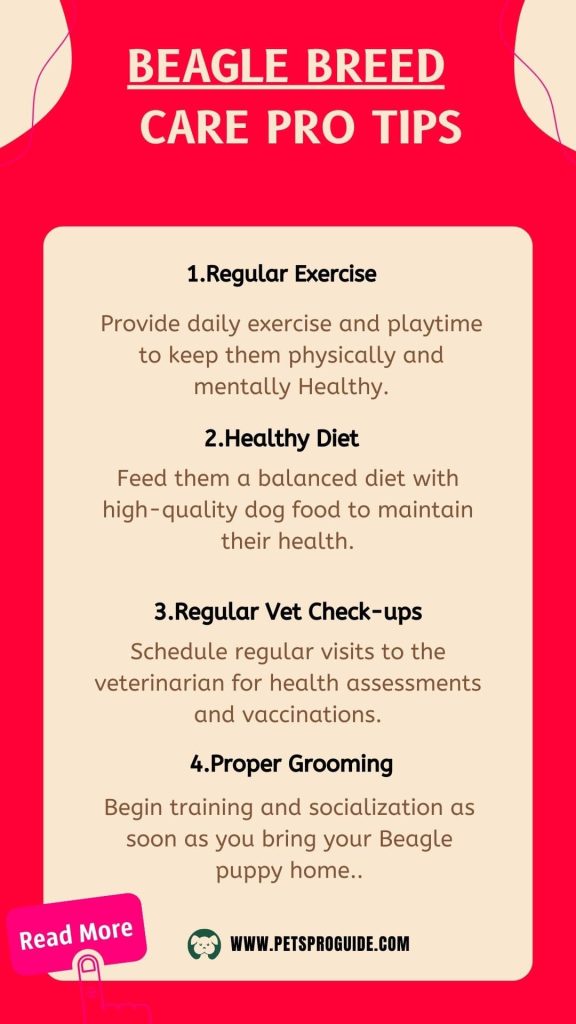Beagle Breed Information: Welcome, readers! Anastasia here, ready to divulge all you need to know about Beagle breed, complete with a delightful compilation of heartwarming pictures!
Welcome to our comprehensive guide on Beagle breed information and pictures. If you’re considering adding a Beagle to your family or simply curious about this charming breed, you’ve come to the right place. In this blog post, we’ll delve into the Beagle’s origins, appearance, personality, grooming needs, health conditions, and much more. So, let’s get started!
- Core statistics
- History and Origins
- Other Names for Beagle Breed
- Beagle Size & Weight
- Appearance
- Personality
- Temperament
- Nutrition and Feeding
- Space Requirements
- Training & Exercise
- Beagle Grooming
- Common Beagle Breed Health Conditions
- Beagle Care Pro Tips
- Is Beagle Good Family Dog?
- What to know before you buy a Beagle?
- Beagle Breed Fun Facts
- FAQs
- 1. Are Beagles good with children?
- 2. Do Beagles shed a lot?
- 3. Are Beagles easy to train?
- 4. Do Beagles get along with other pets?
- 5. How much exercise do Beagles need?
- 6. Are Beagles good watchdogs?
- 7. Are Beagles suitable for apartment living?
- 8. Are Beagles hypoallergenic?
- 9. How often should I groom my Beagle?
- 10. Are Beagles prone to separation anxiety?
- Conclusion
- Read More

Core statistics
Here are some core statistics:
- Size: Small to medium
- Coat: Short and glossy, requires weekly grooming
- Exercise: 2+ hours a day
- Life span: 12-15 years
- Breed group: Gundog
- Temperament: Easy-going, loyal, affectionate
History and Origins
The Beagle breed’s origin can be traced back to ancient times, where their ancestors were bred for hunting purposes. They are believed to have originated in England, with references to Beagle-like hounds dating back to the Roman era. Over the centuries, these dogs were selectively bred to create the Beagles we know and love today.
Other Names for Beagle Breed
Here are some other names for Beagle Breed:
- English Beagle
- Standard Beagle
- Miniature Beagle
- Pocket Beagle
Beagle Size & Weight
- Male Beagle:
- Size: 14-16 inches (35.5-40.6 cm) tall at the shoulder
- Weight: 22-25 pounds (10-11 kg)
- Life Expectancy: 12-15 years
- Female Beagle:
- Size: Slightly smaller than males, typically 13-15 inches (33-38 cm) tall at the shoulder
- Weight: 20-23 pounds (9-10 kg)
- Life Expectancy: 12-15 years
Appearance
The Beagle is a medium-sized breed with a distinctive appearance. They have a sturdy, compact body and a well-muscled frame. Their short, dense coat comes in various colors, including tricolor (black, tan, and white) and bicolor (lemon and white).
Personality
Beagles are known for their friendly and sociable nature. They are curious, intelligent, and affectionate dogs that form strong bonds with their families. Their playfulness and gentle demeanor make them excellent companions, especially for families with children.
Temperament
Beagles have a cheerful and outgoing temperament. They have an excellent sense of smell, which is deeply ingrained in their hunting instincts. As a result, they can sometimes get easily distracted by scents during walks or playtime. Early socialization and training are essential to channel their hunting instincts effectively.
Nutrition and Feeding
Proper nutrition is crucial to keep your Beagle healthy and active. Feed them a balanced diet with high-quality dog food that meets their age, size, and activity level. Divide their daily food into two meals to prevent overeating and obesity. Always ensure a fresh supply of clean water is available.
Space Requirements
- Beagle Puppy: Beagle puppies are energetic and playful, requiring enough space to run around and explore. A securely fenced backyard is ideal for them to burn off their energy safely.
- Adult Beagle: Adult Beagles are adaptable and can live in apartments or houses. However, they still need regular outdoor exercise and mental stimulation to keep them happy and prevent boredom.
Training & Exercise
- Beagle Puppy: Beagle puppies are energetic and playful, requiring enough space to run around and explore. A securely fenced backyard is ideal for them to burn off their energy safely.
- Adult Beagle: Adult Beagles are adaptable and can live in apartments or houses. However, they still need regular outdoor exercise and mental stimulation to keep them happy and prevent boredom.

Beagle Grooming
Beagles are intelligent dogs, but they can also be a bit stubborn, making training a mix of challenge and fun. Here are ten training and exercise tips for your Beagle:
- Start early: Begin training and socialization as soon as you bring your Beagle puppy home.
- Use positive reinforcement: Reward-based training with treats and praise works best for Beagles.
- Keep it interesting: Keep training sessions engaging and short to maintain their focus.
- Leash training: Beagles have a strong prey drive, so leash training is essential to prevent chasing behaviors.
- Mental stimulation: Engage their minds with puzzle toys and interactive games to prevent boredom.
- Be patient: Beagles may take time to grasp commands, so patience is key during training.
- Consistency: Use consistent cues and commands to avoid confusion.
- Socialization: Expose your Beagle to various environments, people, and other dogs to promote good behavior.
- Be firm but gentle: Use a gentle approach in training, as harsh methods may lead to fear or anxiety.
- Supervised playtime: Provide plenty of opportunities for play and exercise to keep them physically and mentally fit.

Common Beagle Breed Health Conditions
While Beagles are generally healthy dogs, they can be prone to certain health conditions. It’s essential to be aware of these potential issues and monitor your Beagle’s health closely. Here are ten common health conditions in Beagles:
- Hip Dysplasia
- Cherry Eye
- Ear Infections
- Glaucoma
- Hypothyroidism
- Epilepsy
- Obesity
- Intervertebral Disc Disease (IVDD)
- Patellar Luxation
- Distichiasis
Beagle Care Pro Tips
Here are ten care tips to ensure your Beagle’s well-being and happiness:
- Regular veterinary check-ups
- Adequate exercise and mental stimulation
- Provide a balanced diet and monitor food intake
- Keep up with grooming routines
- Training and socialization from an early age
- Safe and secure fencing for outdoor play
- Regular dental care
- Keep them at a healthy weight to avoid obesity-related issues
- Be mindful of their sensitive noses during outdoor activities
- Provide lots of love and attention as they thrive on companionship.

Is Beagle Good Family Dog?
Absolutely! Beagles are wonderful family dogs due to their friendly, affectionate nature and love for children. They get along well with other pets too, making them a great addition to multi-pet households.
What to know before you buy a Beagle?
Before bringing a Beagle into your home, consider these ten important points:
- Be prepared for regular exercise needs.
- Beagles are vocal and may howl or bay.
- Early training and socialization are vital.
- They may have a strong prey drive and may chase small animals.
- Grooming requirements are relatively low, but regular brushing is essential.
- Beagles are scent hounds, so they may follow their nose, which could lead to wandering if not kept on a leash.
- They are pack animals and may experience separation anxiety if left alone for extended periods.
- Beagles require mental stimulation to prevent boredom and behavioral issues.
- Their friendly nature makes them poor guard dogs.
- Adopting from a reputable breeder or rescue is crucial to ensure a healthy and well-adjusted pup.
Beagle Breed Fun Facts
Here are ten fun and interesting facts about Beagles:
- Beagles are excellent scent detection dogs and are used in various professional capacities, including detecting bedbugs and illegal substances.
- The Beagle’s sense of smell is so keen that it can detect some diseases in humans, such as cancer.
- Snoopy, the famous cartoon character, is a Beagle!
- Beagles have a distinctive howl, known as “baying,” which they use to communicate with other dogs during hunts.
- Beagles are one of the oldest dog breeds still in existence, with a history dating back thousands of years.
- Beagles were popular hunting companions for English monarchs like Queen Elizabeth I and King Henry VIII.
- Beagles are ranked as one of the top breeds in terms of popularity in the United States.
- The name “Beagle” may have been derived from the Celtic word “beag,” meaning “small.”
- Beagles have a friendly and non-aggressive nature, making them great therapy dogs.
- The Beagle is considered an intelligent breed, but their independence and strong instincts can make training a challenge.
FAQs
1. Are Beagles good with children?
2. Do Beagles shed a lot?
3. Are Beagles easy to train?
4. Do Beagles get along with other pets?
5. How much exercise do Beagles need?
6. Are Beagles good watchdogs?
7. Are Beagles suitable for apartment living?
8. Are Beagles hypoallergenic?
9. How often should I groom my Beagle?
10. Are Beagles prone to separation anxiety?
Conclusion
Beagles are lovable, friendly, and intelligent dogs that make wonderful family companions. Their affectionate nature and moderate grooming needs make them an ideal choice for many households. However, it’s essential to provide them with regular exercise, training, and mental stimulation to keep them happy and well-adjusted. Before bringing a Beagle into your home, consider their unique traits and needs to ensure a rewarding and fulfilling relationship with your new furry friend.
If you really enjoyed the article “Beagle Breed Information and Pictures,” then I would be very grateful if you’d help it spread by emailing it to your friends or sharing it on Twitter, Instagram, or Facebook. Thank you!




Read More
5 Signs to Tell If Your Leopard Gecko Is Happy
Unlocking the happiness of your leopard gecko is crucial for its well-being and your bond…
10 Awesome Turtle Facts You Will Love to Know
Delve into the intriguing world of turtles with our exploration of 12 awesome turtle facts…
10 Snake Myths & Misconceptions You Need to Stop Believing
Snakes, with their slithery movements and often misunderstood nature, have sparked countless myths and misconceptions…
How to Choose the Right Cage Size for Hamsters?
Discovering the perfect habitat for your furry friend is crucial for their health and happiness….
25 Fun Facts About Rabbits You Should Know
Delve into the enchanting world of rabbits with our captivating compilation of 25 Fun Facts…
Lovebirds Cage Size Guide: Choosing the Perfect Habitat for Your Feathered Friends
Welcome to the comprehensive Lovebirds Cage Size Guide, your go-to resource for creating the perfect…













